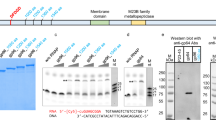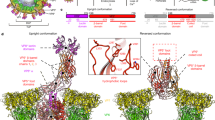Abstract
The ability of polyoma virus to transform cells results primarily from the action of one of the virus-coded early proteins, called middle-T antigen1–3. Middle-T has an associated tyrosine-specific protein kinase activity that can be measured in vitro and results in the phosphorylation of middle-T itself4–7. Almost all mutants so far tested that lack the ability to transform cells, also lack associated kinase activity2,4. Attempts to map within middle-T the tyrosine residue(s) that are phosphorylated in vitro suggest that a likely site of phosphorylation is tyrosine 315 (refs8–10 and unpublished results). The amino acid sequence preceding Tyr 315 includes a tract of six contiguous glutamic acid residues and bears some homology with that preceding the tyrosine phosphorylated in vivo in pp60v–src, the transforming protein of Rous sarcoma virus11, and with a region in the polypeptide hormone, gastrin, preceding a tyrosine that is sulphated12. Furthermore, although surprisingly large tracts of middle-T may be removed without affecting its transforming activity2,13–16, mutants that lack the sequences corresponding to amino acids 311–318 inclusive are transformation defective. Because the likely site of phosphorylation, the homology with pp60v–src and gastrin and the sequence apparently required for transformation all overlap, it has generally been accepted that this region of middle-T may form part of an essential region, possibly an active site on the protein17. Here we have used techniques of site-directed and site-specific mutagenesis to probe the sequence requirements in more detail. Contrary to expectation, the results obtained strongly suggest that Tyr 315 and conservation of the surrounding amino acid sequence are not essential for transformation.
This is a preview of subscription content, access via your institution
Access options
Subscribe to this journal
Receive 51 print issues and online access
$199.00 per year
only $3.90 per issue
Buy this article
- Purchase on Springer Link
- Instant access to full article PDF
Prices may be subject to local taxes which are calculated during checkout
Similar content being viewed by others
References
Tooze, J. DNA Tumor Viruses 2nd edn, Pt 2 (Cold Spring Harbor Laboratory, New York, 1980).
Smith, A. E. & Ely, B. K. in Advances in Viral Oncology Vol. 3 (ed. Klein, G.) 3–30 (Raven, New York, 1983).
Treisman, R., Novak, U., Favaloro, J. & Kamen, R. Nature 292, 595–600 (1981).
Smith, A. E., Smith, R., Griffin, B. & Fried, M. Cell 18, 915–924 (1979).
Eckhart, W., Hutchinson, M. A. & Hunter, T. Cell 18, 925–933 (1979).
Schaffhausen, B. S. & Benjamin, T. L. Cell 18, 935–946 (1979).
Smith, A. E., Fried, M., Ito, Y., Spurr, N. & Smith, R. Cold Spring Harb. Symp. quant. Biol. 44, 141–147 (1980).
Smith, A. E. in Protein Phosphorylation and Bioregulation (eds Thomas, G., Podesta, E. & Gordon, J.) 219–228 (Karger, Basel, 1980).
Schaffhausen, B. & Benjamin, T. J. Virol. 40, 184–196 (1981).
Schaffhausen, B. & Benjamin, T. in Cold Spring Harbor Conf. Cell Proliferation Vol. 8 (eds Rosen, O. M. & Krebs, E. G.) 1281–1298 (1981).
Smart, J. E. et al. Proc. natn. Acad. Sci. U.S.A. 78, 6013–6017 (1981).
Baldwin, G. S. FEBS Lett. 137, 1–5 (1982).
Griffin, B. E. & Maddock, C. J. J. Virol. 31, 645–656 (1979).
Bendig, M., Thomas, T. & Folk, W. J. Virol. 33, 1215–1219 (1980).
Magnusson, G., Nilsson, M. J., Dilworth, S. M. & Smolar, N. J. Virol. 39, 673–683 (1981).
Nilsson, S., Tyndall, C. & Magnusson, G. J. Virol. 46, 284–287 (1983).
Patschinsky, T., Hunter, T., Esch, F. S., Cooper, J. A. & Sefton, B. M. Proc. natn. Acad. Sci. U.S.A. 79, 973–977 (1982).
Kalderon, D., Oostra, B. A., Ely, B. K. & Smith, A. E. Nucleic Acids Res. 10, 5161–5171 (1982).
Edge, M. D. et al. Nature 292, 756–761 (1981).
Shortle, D., DiMaio, D. & Nathans, D. A. Rev. Genet. 15, 265–294 (1981).
Graham, F. L. & van der Eb, A. Virology 52, 456–458 (1973).
MacPherson, I. & Montagnier, L. Virology 23, 291–294 (1964).
Walter, G., Hutchinson, M. A., Hunter, T. & Eckhart, W. Proc. natn. Acad. Sci. U.S.A. 78, 4882–4886 (1981).
Ding, D., Dilworth, S. M. & Griffin, B. E. J. Virol. 44, 1080–1083 (1982).
Dilworth, S. EMBO J. 1, 1319–1328 (1982).
Segawa, K. & Ito, Y. Proc. natn. Acad. Sci. U.S.A. 79, 6812–6816 (1982).
Courtneidge, S. A. & Smith, A. E. Nature 303, 435–139 (1983).
Snyder, M. A., Bishop, J. M., Colby, W. W. & Levinson, D. A. Cell 32, 891–901 (1983).
Author information
Authors and Affiliations
Rights and permissions
About this article
Cite this article
Oostra, B., Harvey, R., Ely, B. et al. Transforming activity of polyoma virus middle-T antigen probed by site-directed mutagenesis. Nature 304, 456–459 (1983). https://doi.org/10.1038/304456a0
Received:
Accepted:
Issue Date:
DOI: https://doi.org/10.1038/304456a0
This article is cited by
-
Molecular analysis of metastasis in a polyomavirus middle T mouse model: the role of osteopontin
Breast Cancer Research (2004)
-
O–Glycosylation and Novel Processing Events During Secretion of α–Factor/GM–CSF Fusions by Saccharomyces cerevisiae
Nature Biotechnology (1987)
-
Association of phosphatidylinositol kinase activity with polyoma middle-T competent for transformation
Nature (1985)
-
Improvement Of Oligonucleotide-Directed Site-Specific Mutagenesis Using Double-Stranded Plasmid DNA
Nature Biotechnology (1984)
Comments
By submitting a comment you agree to abide by our Terms and Community Guidelines. If you find something abusive or that does not comply with our terms or guidelines please flag it as inappropriate.



